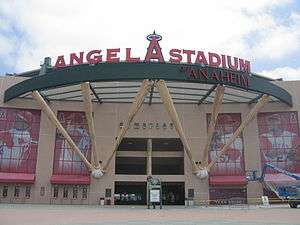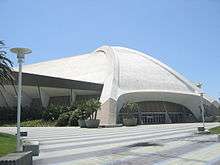Gene Autry
| Gene Autry | |
|---|---|
|
Gene Autry circa 1940s | |
| Background information | |
| Birth name | Orvon Grover Autry |
| Also known as | The Singing Cowboy |
| Born |
September 29, 1907 Tioga, Texas, U.S. |
| Died |
October 2, 1998 (aged 91) Studio City, California, U.S. |
| Genres | Country, western music |
| Occupation(s) | Musician, songwriter, actor |
| Instruments | Guitar, vocals |
| Years active | 1931–1988 |
| Labels | Columbia, Okeh, Perfect, Conqueror |
| Website |
geneautry |
Orvon Grover "Gene" Autry[1] (September 29, 1907 – October 2, 1998) was an American performer who gained fame as a singing cowboy on the radio, in movies, and on television for more than three decades beginning in the early 1930s. Autry was also owner of a television station, several radio stations in Southern California, and the Los Angeles/California/Anaheim Angels Major League Baseball team from 1961 to 1997.
From 1934 to 1953, Autry appeared in 93 films and 91 episodes of The Gene Autry Show television series. During the 1930s and 1940s, he personified the straight-shooting hero—honest, brave, and true—and profoundly touched the lives of millions of Americans.[2] Autry was also one of the most important figures in the history of country music, considered the second major influential artist of the genre's development after Jimmie Rodgers.[2] His singing cowboy movies were the first vehicle to carry country music to a national audience.[2] In addition to his signature song, "Back in the Saddle Again", Autry is still remembered for his Christmas holiday songs, "Here Comes Santa Claus", which he wrote, "Frosty the Snowman", "An Old Fashioned Tree", and his biggest hit, "Rudolph the Red-Nosed Reindeer".
Autry was a member of both the Country Music Hall of Fame and Nashville Songwriters Hall of Fame, and is the only person to be awarded stars in all five categories on the Hollywood Walk of Fame, for film, television, music, radio, and live performance.[3] The town of Gene Autry, Oklahoma was named in his honor.[4]
Life and career
Early years
Orvon Grover Autry was born September 29, 1907 near Tioga in Grayson County in north Texas, the grandson of a Methodist preacher. His parents, Delbert Autry and Elnora Ozment, moved in the 1920s to Ravia in Johnston County in southern Oklahoma. He worked on his father's ranch while at school. After leaving high school in 1925, Autry worked as a telegrapher for the St. Louis–San Francisco Railway. His talent at singing and playing guitar led to performing at local dances.
Singing career
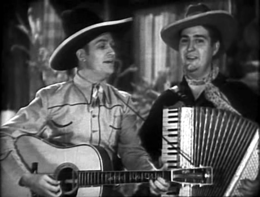
While working as a telegrapher, Autry would sing and accompany himself on the guitar to pass the lonely hours, especially when he had the midnight shift. This later got him sacked. One night, he was encouraged to sing professionally by a customer, the famous humorist Will Rogers, who had heard Autry singing.[5][6][7]
As soon as he could collect money to travel, he went to New York. He auditioned for Victor Records, about the time it became RCA Victor (end of 1928). According to Nathaniel Shilkret,[8] director of Light Music for Victor at the time, Autry asked to speak to Shilkret when Autry found that he had been turned down. Shilkret explained to Autry that he was turned down not because of his voice, but because Victor had just made contracts with two similar singers. Autry left with a letter of introduction from Shilkret and the advice to sing on radio to gain experience and to come back in a year or two. In 1928, Autry was singing on Tulsa's radio station KVOO as "Oklahoma's Yodeling Cowboy", and the Victor archives[9] show an October 9, 1929, entry stating that the vocal duet of Jimmie Long and Gene Autry with two Hawaiian guitars, directed by L. L. Watson, recorded "My Dreaming of You" (Matrix 56761) and "My Alabama" (Matrix 56762).
Autry signed a recording deal with Columbia Records in 1929. He worked in Chicago on the WLS-AM radio show National Barn Dance for four years, and with his own show, where he met singer-songwriter Smiley Burnette. In his early recording career, Autry covered various genres, including a labor song, "The Death of Mother Jones", in 1931.
Autry also recorded many "hillbilly"-style records in 1930 and 1931 in New York City, which were certainly different in style and content from his later recordings. These were much closer in style to the Prairie Ramblers or Dick Justice, and included the "Do Right, Daddy Blues" and "Black Bottom Blues", both similar to "Deep Elem Blues". These late Prohibition-era songs deal with bootlegging, corrupt police, and women whose occupation was certainly vice. These recordings are generally not heard today, but are available on European import labels, such as JSP Records. His first hit was in 1932 with "That Silver-Haired Daddy of Mine", a duet with fellow railroad man, Jimmy Long, which Autry and Long co-wrote.
Autry also sang the classic Ray Whitley hit "Back in the Saddle Again",[10] as well as many Christmas holiday songs, including "Santa Claus Is Coming to Town", his own composition "Here Comes Santa Claus", "Frosty the Snowman", and his biggest hit, "Rudolph the Red-Nosed Reindeer". He wrote "Here Comes Santa Claus" after being the Grand Marshal of the 1946 Santa Claus Lane Parade (Now the Hollywood Christmas Parade). He heard all of the spectators watching the parade saying "Here comes Santa Claus!" virtually handing him the title for his song. He recorded his version of the song in 1947 and it became an instant classic.
Autry was the original owner of Challenge Records. The label's biggest hit was "Tequila" by The Champs in 1958, which started the rock-and-roll instrumental craze of the late 1950s and early 1960s. He sold the label soon after, but the maroon and later green label has the "GA" in a shield above the label name.
Autry made 640 recordings, including more than 300 songs written or co-written by himself. His records sold more than 100 million copies and he has more than a dozen gold and platinum records, including the first record ever certified gold.
Film career
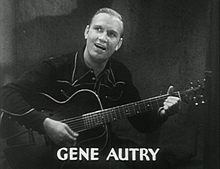
Discovered by film producer Nat Levine in 1934, Autry and Burnette made their film debut for Mascot Pictures Corp. in In Old Santa Fe as part of a singing cowboy quartet; he was then given the starring role by Levine in 1935 in the 12-part serial The Phantom Empire. Shortly thereafter, Mascot was absorbed by the newly formed Republic Pictures Corp. and Autry went along to make a further 44 films up to 1940, all B Westerns in which he played under his own name, rode his horse, Champion, had Burnette as his regular sidekick, and had many opportunities to sing in each film. Pat Buttram was picked by Gene Autry, recently returned from his World War II service in the United States Army Air Forces, to work with him. Buttram would co-star with Gene Autry in more than 40 films and in over 100 episodes of Autry's television show

In the Motion Picture Herald Top Ten Money-Making Western Stars poll, Autry was listed every year from 1936 to 1942 and 1946 to 1954 (he was serving in the AAF 1943–45), holding first place 1937 to 1942, and second place (after Roy Rogers) 1947 to 1954.[11] He appeared in the similar Box Office poll from 1936 to 1955, holding first place from 1936 to 1942 and second place (after Rogers) from 1943 to 1952.[12] While these two polls are really an indication only of the popularity of series stars, Autry also appeared in the Top Ten Money Makers Poll of all films from 1940 to 1942,[13] His Gene Autry Flying "A" Ranch Rodeo show debuted in 1940.[14]
Gene Autry was the first of the singing cowboys in films, but was succeeded as the top star by Roy Rogers while Autry served in the AAF during World War II. He briefly returned to Republic to finish out his contract, which had been suspended for the duration of his military service and which he had tried to have declared void after his discharge. He appeared in 1951 in the film Texans Never Cry, with a role for newcomer Mary Castle. After 1951, Autry formed his own production company to make Westerns under his own control, which continued the 1947 distribution agreement with Columbia Pictures.
Melody Ranch
Autry purchased the 110-acre Monogram Movie Ranch in 1953, in Placerita Canyon near Newhall, California, in the northern San Gabriel Mountains foothills. He renamed it the Melody Ranch after his movie Melody Ranch.[15] Autry then sold 98 acres of the property, most of the original ranch. The Western town, adobes, and ranch cabin sets and open land for location shooting were retained as a movie ranch on 12 acres. A decade after he purchased Melody Ranch, a brushfire swept through in August 1962, destroying most of the original standing sets. However, the devastated landscape did prove useful for productions such as Combat!. A complete adobe ranch survived at the northeast section of the ranch.[16][17]
In 1990, after his favorite horse Champion, which lived in retirement there, died, Autry put the remaining 12-acre ranch up for sale. It is now known as the Melody Ranch Motion Picture Studio and Melody Ranch Studios on 22 acres.[18] The ranch has Melody Ranch Museum open year-round; and one weekend a year, the entire ranch is open to the public during the Cowboy Poetry and Music Festival, another legacy of Autry's multiple talents.[19][20]
Radio and television career
From 1940 to 1956, Autry had a huge hit with a weekly show on CBS Radio, Gene Autry's Melody Ranch. His horse, Champion, also had a CBS-TV and Mutual radio series, The Adventures of Champion. In response to his many young radio listeners aspiring to emulate him, Autry created the Cowboy Code, or Ten Cowboy Commandments. These tenets promoting an ethical, moral, and patriotic lifestyle that appealed to youth organizations such as the Boy Scouts, which developed similar doctrines. The Cowboy Code consisted of rules that were "a natural progression of Gene's philosophies going back to his first Melody Ranch programs—and early pictures."[21] According to the code:
- The Cowboy must never shoot first, hit a smaller man, or take unfair advantage.
- He must never go back on his word, or a trust confided in him.
- He must always tell the truth.
- He must be gentle with children, the elderly, and animals.
- He must not advocate or possess racially or religiously intolerant ideas.
- He must help people in distress.
- He must be a good worker.
- He must keep himself clean in thought, speech, action, and personal habits.
- He must respect women, parents, and his nation's laws.
- The Cowboy is a patriot.
Beginning in 1950, he produced and starred in his own television show on CBS through his Flying A Productions studio and made several appearances on ABC-TV's Jubilee USA in the late 1950s.
Military career
During World War II, Autry enlisted in the United States Army in 1942, and became a tech sergeant in the United States Army Air Corps. Holding a private pilot's license, he was determined to become a military pilot and earned his service pilot rating in June 1944, serving as a C-109 transport pilot with the rank of flight officer. Assigned to a unit of the Air Transport Command, he flew as part of the dangerous airlift operation over the Himalayas between India and China, nicknamed the Hump.[22][23]
Rodeo
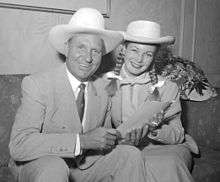
Few are aware of Autry's longtime involvement in professional rodeo. In 1942, at the height of his screen popularity, Autry had a string of rodeo stock based in Ardmore, Oklahoma. A year later, he became a partner in the World Championship Rodeo Company, which furnished livestock for many of the country's major rodeos. In 1954, he acquired Montana's top bucking string from the estate of Leo J. Cremer, Sr., and put Canadian saddle bronc riding champion Harry Knight in charge of the operation. A merger with the World Championship Rodeo Company in 1956 made Autry the sole owner. He moved the entire company to a 24,000-acre (97 km2) ranch near Fowler, Colorado, with Knight as the working partner in the operation. For the next 12 years, they provided livestock for most of the major rodeos in Texas, Colorado, Montana, and Nebraska. When the company was sold in 1968, both men continued to be active in rodeo. For his work as a livestock contractor, Autry was inducted into the Professional Rodeo Cowboys Association's ProRodeo Hall of Fame in 1979.
Retirement
Autry retired from show business in 1964, having made almost 100 films up to 1955 and over 600 records. He was elected to the Country Music Hall of Fame in 1969 and to the Nashville Songwriters Hall of Fame in 1970. After retiring, he invested widely and in real estate, radio, and television. He also invested in ownership of the KOOL-TV CBS-affiliate in Phoenix, Arizona, which created local shows such as the weekly bilingual children's show Ninos Contentos. He also purchased the rights from the dying Republic Pictures for films he had made for the company.
In 1952, Autry bought the old Monogram Ranch in Placerita Canyon (Newhall-Santa Clarita, California,) and renamed it Melody Ranch. Numerous "B" Westerns and TV shows were shot there during Autry's ownership, including the initial years of Gunsmoke with James Arness. Melody Ranch burned down in 1962, dashing Autry's plans to turn it into a museum. According to a published story by Autry, the fire caused him to turn his attention to Griffith Park, where he would build his Museum of Western Heritage (now known as the Autry National Center). Melody Ranch came back to life after 1991, when it was purchased by the Veluzat family and rebuilt. It survives as a movie location today, as well as the home of the City of Santa Clarita's annual Cowboy Festival, where Autry's legacy takes center stage.
Baseball
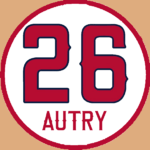
In the 1950s, Autry had been a minority owner of the minor-league Hollywood Stars. In 1960, when Major League Baseball announced plans to add an expansion team in Los Angeles, Autry—who had once declined an opportunity to play in the minor leagues—expressed an interest in acquiring the radio broadcast rights to the team's games. Baseball executives were so impressed by his approach that he was persuaded to become the owner of the franchise rather than simply its broadcast partner. The team, initially called the Los Angeles Angels upon its 1961 debut, moved to suburban Anaheim in 1966, and was renamed the California Angels, then the Anaheim Angels from 1997 until 2005, when it became the Los Angeles Angels of Anaheim. Autry served as vice president of the American League from 1983 until his death. In 1995, he sold a quarter share of the team to the Walt Disney Company and a controlling interest the following year, with the remaining share to be transferred after his death. Earlier, in 1982, he sold Los Angeles television station KTLA for $245 million. He also sold several radio stations he owned, including KSFO in San Francisco, KMPC in Los Angeles, KOGO in San Diego, and other stations in the Golden West radio network.
The number 26 (as in 26th man) was retired by the Angels in Autry's honor. The chosen number reflected that baseball's rosters are 25-man strong, so Autry's unflagging support for his team made him the 26th member.
Death
Gene Autry died of lymphoma on October 2, 1998, aged 91 at his home in Studio City, California. He was buried at the Forest Lawn, Hollywood Hills Cemetery in Los Angeles.[24] His epitaph read, "America's Favorite Cowboy ... American Hero, Philanthropist, Patriot and Veteran, Movie Star, Singer, Composer, Baseball Fan and Owner, 33rd Degree Mason, Media Entrepreneur, Loving Husband, Gentleman".[24]
Personal life
In 1932, Autry married Ina May Spivey, the niece of Jimmy Long. After she died in 1980, he married Jacqueline Ellam, who had been his banker, in 1981. He had no children by either marriage.
Autry was raised into Freemasonry in 1927 at Catoosa Lodge No. 185, Catoosa Oklahoma. He later became a 33rd degree Master Mason, as recorded on his headstone.[25]
Legacy
On November 16, 1941, the town of Berwyn, Oklahoma, north of Ardmore, was renamed in honor of Gene Autry.[26]
In 1972, he was inducted into the Western Performers Hall of Fame at the National Cowboy & Western Heritage Museum in Oklahoma City, Oklahoma. Autry was a life member of the Benevolent and Protective Order of Elks, Burbank Lodge No. 1497. His 1976 autobiography, co-written by Mickey Herskowitz, was titled Back in the Saddle Again after his 1939 hit and signature tune. He is also featured year after year, on radio and "shopping mall music" at the holiday season, by his recording of "Rudolph the Red-Nosed Reindeer." "Rudolph" became the first No. 1 hit of the 1950s. In 2003, he was ranked No. 38 in CMT's list of the 40 Greatest Men of Country Music.
When the Anaheim Angels won their first World Series in 2002, much of the championship was dedicated to him. The interchange of Interstate 5 and State Route 134, near the Autry National Center in Los Angeles, is signed as the "Gene Autry Memorial Interchange." In 2007, he became a charter member of the Gennett Records Walk of Fame in Richmond, Indiana.
Johnny Cash recorded a song in 1978 about Autry called "Who is Gene Autry?" Cash also got Autry to sign his famous black Martin D-35 guitar, which he plays in the video of "Hurt."
In 1977, Autry was awarded the American Patriots Medal by Freedoms Foundation of Valley Forge, Pennsylvania. Other winners of this medal were Helen Hayes, John Wayne, and Texas State Representative Clay Smothers.[27]
Autry was inducted into the Radio Hall of Fame in 2003. In 2004, the Starz Entertainment Corporation joined forces with the Autry estate to restore all of his films, which have been shown on Starz's Encore Western Channel on cable television on a regular basis to date since.
Autry was inducted into the Oklahoma Hall of Fame in 1991.[26]
Hollywood Walk of Fame
Autry is the only person to have five stars on the Hollywood Walk of Fame, one in each of the five categories maintained by the Hollywood Chamber of Commerce.[28]
- Motion pictures, at 6644 Hollywood Blvd.
- Radio, at 6520 Hollywood Blvd.
- Recording, at 6384 Hollywood Blvd.
- Television, at 6667 Hollywood Blvd.
- Live theater, at 7000 Hollywood Blvd.
The Museum of the American West
The Museum of the American West in Los Angeles' Griffith Park was founded in 1988 as the Gene Autry Western Heritage Museum, featuring much of his collection of Western art and memorabilia. It is now called The Autry National Center and is divided into two locations, eight miles apart from each other. Its mission is to present the unique and diverse perspectives of the American West, including the romanticized West in pop culture and the "real" nuanced history, including native and minority voices.
Discography
Albums
| Year | Album | US Country | Label |
|---|---|---|---|
| 1976 | South of the Border, All American Cowboy | 42 | Republic |
| Cowboy Hall of Fame | 44 |
Singles
1930s
| Year | Single |
|---|---|
| 1931 | "A Face I See at Evening" |
| 1933 | "The Last Round-Up" |
| 1934 | "Cowboy's Heaven" |
| 1935 | "That Silver-Haired Daddy of Mine" (w/ Jimmy Long) |
| "Tumbling Tumbleweeds" | |
| "Mexicali Rose" | |
| "Take Me Back to My Boots and Saddle" | |
| 1937 | "Gold Mine in the Sky" |
| 1939 | "South of the Border" |
| "Back in the Saddle Again" | |
1940s
| Year | Single | Chart Positions | |||||||
|---|---|---|---|---|---|---|---|---|---|
| US Country | US | ||||||||
| 1941 | "Blueberry Hill" | ||||||||
| "You Are My Sunshine"[29] | |||||||||
| "Lonely River"[30] | |||||||||
| 1944 | "I'm Thinking Tonight of My Blue Eyes" | 3 | — | ||||||
| "I Hang My Head and Cry" | 4 | — | |||||||
| 1945 | "Gonna Build a Big Fence Around Texas" | 2 | — | ||||||
| "Don't Fence Me In" | 4 | — | |||||||
| "At Mail Call Today" | 1 | — | |||||||
| "I'll Be Back" | 7 | — | |||||||
| "Don't Hang Around Me Anymore" | 4 | — | |||||||
| "I Want to Be Sure" | 4 | — | |||||||
| "Don't Live a Lie" | 4 | — | |||||||
| 1946 | "Silver Spurs (On the Golden Stairs)" | 4 | — | ||||||
| "I Wish I Had Never Met Sunshine" | 3 | — | |||||||
| "Wave to Me, My Lady" | 4 | — | |||||||
| "You Only Want Me When You're Lonely" | 7 | — | |||||||
| "Have I Told You Lately that I Love You?" | 3 | — | |||||||
| "Someday (You'll Want Me to Want You)" | 4 | — | |||||||
| "Over and Over Again" | — | ||||||||
| 1947 | "You're Not My Darlin' Anymore" | 3 | — | ||||||
| 1948 | "Here Comes Santa Claus (Down Santa Claus Lane)" | 5 | 9 | ||||||
| "Buttons and Bows" | 6 | 17 | |||||||
| "Here Comes Santa Claus (Right Down Santa Claus Lane)" | 4 | 8 | |||||||
| 1949 | "Ghost Riders in the Sky" | — | — | ||||||
| "Rudolph the Red-Nosed Reindeer" (w/ The Pinafores) | 1 | 1 | |||||||
| "Here Comes Santa Claus (Right Down Santa Claus Lane)" | 8 | 24 | |||||||
| "—" denotes releases that did not chart | |||||||||
1950s
| Year | Single | Chart Positions | |||||||
|---|---|---|---|---|---|---|---|---|---|
| US Country | US | ||||||||
| 1950 | "Peter Cottontail" | 3 | 5 | ||||||
| "Frosty the Snow Man" (w/ The Cass County Boys) | 4 | 7 | |||||||
| "Rudolph the Red-Nosed Reindeer" (w/ The Pinafores) | 5 | 3 | |||||||
| 1951 | "Old Soldiers Never Die" | 9 | — | ||||||
| 1952 | "Up on the Housetop" | — | — | ||||||
| 1957 | "Nobody's Darlin' but Mine" | — | — | ||||||
| "Rudolph the Red-Nosed Reindeer" (re-entry) | — | 70 | |||||||
| "—" denotes releases that did not chart | |||||||||
1990s
| Year | Single | Chart Positions | |||||||
|---|---|---|---|---|---|---|---|---|---|
| US Country | US AC | ||||||||
| 1998 | "Rudolph the Red-Nosed Reindeer" (re-entry) | 55 | — | ||||||
| 1999 | "Rudolph the Red-Nosed Reindeer" (re-entry) | 60 | 24 | ||||||
| "—" denotes releases that did not chart | |||||||||
Filmography
From 1934 to 1953, Gene Autry appeared in 93 films.[31][Note 1] From 1950 to 1955, he also appeared in 91 episodes of The Gene Autry Show television series.[32][33] As of 2014, a large number of these films and television episodes remain available via the Gene Autry Foundation on the Western Channel (a cable television station), the latter having collaborated with the Foundation to restore the Republic titles, which had been cut to a uniform 54 minutes for television release in the 1950s, to full length and to provide clean negative-based source prints for all the titles in the 1990s.
|
|
|
See also
- Autry National Center of the American West
- Melody Movie Ranch
- Hollywood Christmas Parade
- Gene Autry, Oklahoma
- List of best-selling music artists
- List of Freemasons
Further reading
- New Deal Cowboy: Gene Autry and Public Diplomacy by Michael Duchemin, 2016, University of Oklahoma Press
References
- Notes
- ↑ Autry's first three films were produced by Mascot Pictures. His next 57 films, from Tumbling Tumbleweeds (1935) through Robin Hood of Texas (1947), were produced by Republic Pictures. His final 33 films, from The Last Round-up (1947) through Last of the Pony Riders (1953), were produced by Columbia Pictures.[31]
- Citations
- ↑ George-Warren 2007, p. 13
- 1 2 3 Cusic 2010, p. 1
- ↑ "About Hollywood Star Walk". Los Angeles Times. Retrieved May 27, 2012.
- ↑ Scriba, Jay (October 15, 1970). "From Sleepy Eye to Chicken Bristle, USA". The Milwaukee Journal. Retrieved April 22, 2015.
- ↑ DeLong, Thomas A. (1980). The Mighty Music Box: The Golden Age of Musical Radio. Los Angeles: Amber Crest Books. ISBN 978-0865330009.
- ↑ Smith, Ardis (November 13, 1940). "Autry, First Cowboy of Land, Makes $300,000 Annually". Buffalo New York News.
- ↑ Dabney, Eric. "Orvon Gene Autry (1907–1998)". Encyclopedia of Oklahoma History & Culture. Retrieved May 27, 2012.
- ↑ Shilkret, Nathaniel, ed. Niel Shell and Barbara Shilkret, Nathaniel Shilkret: Sixty Years in the Music Business, Scarecrow Press, Lanham, Maryland, 2005. ISBN 0-8108-5128-8.
- ↑ Victor Recording Book, p. 7247. (This is a page from Victor's daily log of recordings.)
- ↑ Gilliland, John (1969). "Show 9 – Tennessee Firebird: American country music before and after Elvis. [Part 1]" (audio). Pop Chronicles. Digital.library.unt.edu.
- ↑ Phil Hardy The Encyclopedia of Western Movies, London, Octopus, 1985, ISBN 0-8300-0405-X
- ↑ "Quigley Publishing Top Ten MoneyMakers Poll". B Westerns. Retrieved May 27, 2012.
- ↑ "Top Ten Money Making Stars". Quigley Publishing. Archived from the original on December 21, 2014. Retrieved May 27, 2012.
- ↑ "Gene Autry". Internet Movie Database. Retrieved May 27, 2012.
- ↑ http://www.scvhistory.com/scvhistory/sg032903.htm "Movie Magic in Placerita Canyon" www.scvhistory(society). Melody Ranch history. access date: May 15, 2010
- ↑ http://employees.oxy.edu/jerry//melody.htm oxy.edu. Melody Ranch. access date: May 15, 2010
- ↑ http://www.scvleon.com/newhall/autry.htm www.scvleon. "Memories of the place I called Melody Ranch" by Gene Autry. access date:2/2/2008.
- ↑ http://www.melodyranchstudio.com/ www.melodyranchstudio. 'Melody Ranch Motion Picture Studio.' access date: May 15, 2010
- ↑ http://www.melodyranchstudio.com/museum.html www.melodyranchstudio. 'Museum.' access date: May 15, 2010.
- ↑ City of Santa Clarita Cowboy Poetry & Music Festival.
- ↑ George-Warren 2007, p. 256
- ↑ Gene Autry as flight officer
- ↑ "A Plane-Crazy America". AOPA Pilot: 79. May 2014.
- 1 2 Gene Autry at Find a Grave
- ↑ Autry, Gene. "Grand Lodge of BC and the Yukon". Masonic Research. freemasonry.bcy.ca. Retrieved July 28, 2012.
- 1 2 Oklahoma Heritage Association. "Oklahoma Hall of Fame: Gene Autry."
- ↑ "66th Legislature, Resolutions – Congratulatory and Honorary". lrl.state.tx.us. Retrieved October 11, 2013.
- ↑ "Gene Autry.com". Gene Autry Entertainment. Retrieved 2011-03-19.
- ↑ "Second Hand Songs – Song: You Are My Sunshine – Paul Rice". secondhandsongs.com. Retrieved 2010-07-27.
- ↑ "The Online Discographical Project – Okeh (CBS) 6500–6747 (1941–45)". 78discography.com. Retrieved 2011-02-21.
- 1 2 Magers 2007, pp. 21–336
- ↑ Magers 2007, pp. 342–344
- ↑ George-Warren 2007, pp. 382–385
- Bibliography
- Autry, Gene (1978). Back in the Saddle Again. New York: Doubleday. ISBN 978-0385032346.
- Cusic, Don (2010). Gene Autry: His Life and Career. Jefferson: McFarland. ISBN 978-0786459780.
- George-Warren, Holly (2007). Public Cowboy no. 1: The Life and Times of Gene Autry. New York: Oxford University Press. ISBN 978-0195177466.
- Green, Douglas B. (2002). Singing in the Saddle: The History of the Singing Cowboy. Nashville: Vanderbilt University Press. ISBN 978-0826514127.
- Guyot-Smith, Jonathan (1998). Paul Kingsbury, ed. The Encyclopedia of Country Music. New York: Oxford University Press. pp. 22–23. ISBN 978-0195116717.
- Magers, Boyd (2007). Gene Autry Westerns. Madison, North Carolina: Empire Publishing, Inc. ISBN 978-0944019498.
- Richliano, James (2002). Angels We Have Heard: The Christmas Song Stories. New York: Star of Bethlehem Books. pp. 154–219. ISBN 0-9718810-0-6.
External links
- Official website
- Gene Autry at the Internet Movie Database
- Gene Autry at AllMovie
- Gene Autry at the National Radio Hall of Fame
- Autry National Center
- Country Music Hall of Fame and Museum
- Melody Ranch Motion Picture Studio Museum
- Melody Ranch: Movie Magic in Placerita Canyon
- Memories of the Place I Called 'Melody Ranch'
- Santa Clarita Cowboy Festival at Melody Ranch Motion Picture Studio
- Discography of Gene Autry albums
- Gene Autry, "Back in the Saddle Again" Jubilee USA, September 10, 1960
- The Phantom Empire (1935)
- Gene Autry, biography and influences at C.F. Martin & Co. 180 Years of American Music History.
- Zoot Radio, free old time radio show downloads of Gene Autry
- "Cinchset" Gene Autry filming at the Golden Oak Ranch
